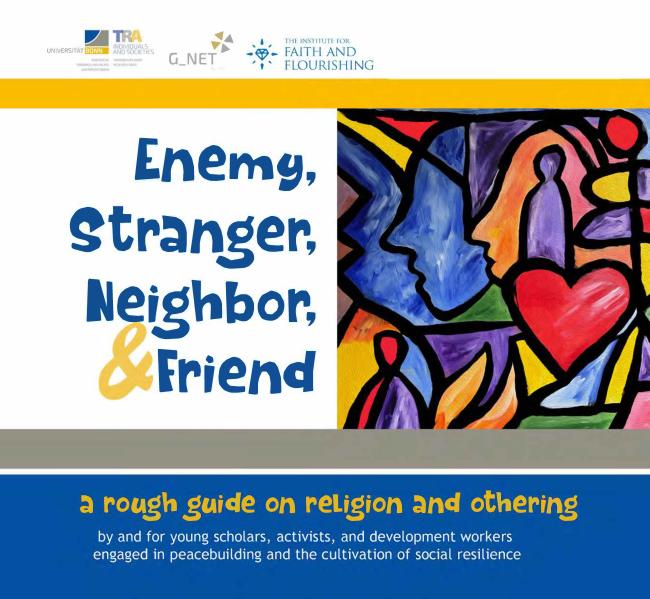Wat voor beeld van “anderen” van binnen en buiten stellen religies voor in hun ideeën, symbolen en praktijken? Hoe beïnvloeden religieuze voorstellingen van anderen de sociale cohesie? En welke rol kunnen jonge leiders spelen bij het aangaan van de uitdagingen en het potentieel die in de voorstellingen van “anderen” in religieuze tradities te vinden zijn om sociale veerkracht te cultiveren?
Enemy, Stranger, Neighbour, & Friend. Rough Guide On Religion and Othering biedt een praktisch hulpmiddel voor groepsstudie en projectontwerp, dat groepen kan inspireren en toerusten om spanningen aan te pakken die naar voren komen in religieuze voorstellingen van “anders-zijn”. De gids bevat vier hoofdstukken over hoe religieuze ideeën, symbolen en praktijken andere personen en groepen voorstellen als vijanden, vreemden, buren en vrienden. De gids bevat anekdotes uit de praktijk, korte essays over elk onderwerp, groepsleesoefeningen die putten uit de heilige geschriften van religieuze tradities uit de hele wereld, en toont een galerij van projecten die jonge leiders hebben ontwikkeld om de uitdagingen van ‘anders-zijn’ aan te gaan door gebruik te maken van de overtuigingen, symbolen en praktijken van hun religieuze tradities.
In de inleiding staat te lezen waarom het belangrijk is om het thema van “anderen” en religie te bespreken, ook met jongeren.
Othering, Relationships, and Religion
The way we see others profoundly influences the society we see around us. The reason is simple: the way we see others defines the quality of our relationships. And the quality of our relationships, as individuals and groups, largely defines what is possible for our society. What do we see growing among and around us – dignity or disrespect, trust or suspicion, cooperation or competition, creativity or conflict, flourishing or suffering?
If the way we see others shapes the society we see, then othering is extremely important for our social
cohesion and resilience. We describe othering simply as seeing others as unrelated or less than ourselves. The othering vision creates a disconnection between people and a sense of unequal value or even a need to exclude or attack others. Othering fuels “us vs. them” mindsets and relationships.Othering often grows out of painful personal or group experiences. It spreads through the words, images, stories, beliefs, and structures that shape us in our families, communities, and wider cultures. When we see others as unrelated or less than ourselves, the door is open to picture others as enemies, which can lead to dehumanizing or demonizing them. And these attitudes, words, and images can lead to violence, war, orgenocide. An escalating cycle of othering is unleashed.
Our action movies vividly illustrate what is at stake in othering: when we see others as unrelated or less—think of Stormtroopers, Orcs, or other (in)famous “bad guys”—we don’t care what happens to them. They may get shot, blown up, or annihilated, and their suffering doesn’t make us feel sad or disturbed. We may even joyfully cheer. What happens on our screens and in our societies is sourced in the way we see others.Our religious beliefs, values, and practices profoundly influence how we see others. And thus, religion can play a very powerful role in othering, both to fuel and to heal it.
Religion can fuel othering by sanctioning our sense of exceptional identity, picturing others as uniquely sinful or even satanic, and justifying our desire to exclude or punish others as God’s will. But religion can also be a powerful force for healing othering. Some of the most basic teachings of our faith traditions—that God has created all people with precious value, that we all make mistakes and need mercy, that we are called by God to practice love and compassion even when “the other” least deserves it—can uproot othering. These religious visions give us new eyes to see that we are fundamentally connected as people and equal in precious value, even in our disagreements and conflicts. And these visions are vital for cultivating social resilience and mutual flourishing.
This manual invites us to explore the rich resources in our diverse faith traditions for healing othering, cultivating shared flourishing, and practicing hope in our relationships with enemies, strangers, neighbors, and friends.
Je kunt het boek hier inzien en downloaden.

